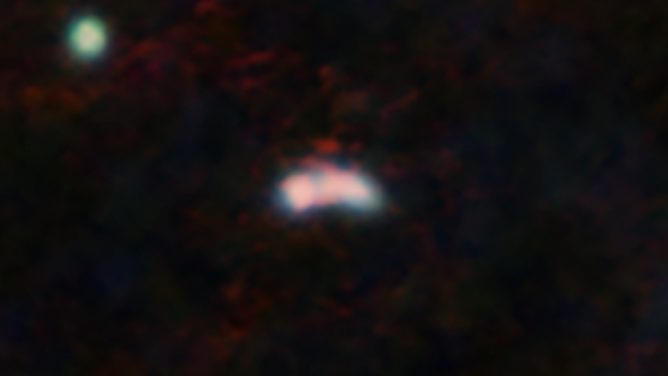2021.02.09
Discovery of Interaction between Jet and Disk Wind from a Star-Forming Accretion Disk

(Left) ALMA composite image of dust emission (gray image), SO emission (orange), and SiO emission (green) towards the center of the HH 212 star-forming system. Accretion disk is seen in dust emission, jet is seen in SiO and SO emission along the symmetric axis, bow shocks are seen in SiO emission at large distances from the protostar. Faint wind is seen in SO emission, fanning out from the disk. The shells produced by the jet-wind interaction is also seen in SO emission, connecting to the bow shocks at large distances. Credit: ALMA (ESO/NAOJ/NRAO)/Lee et al. (Right) An artistic conception showing the disk, jet, wind (greenish), and shells in the system.
Credit: Ya-Ling Huang/ASIAA
“Thanks to the powerful ALMA, we spatially resolve a previously detected disk wind in the HH 212 star-forming system and confirm it to be a magnetic wind launched from an accretion disk”, says Chin-Fei Lee at ASIAA with excitement. “In addition, we also detect its interaction with the jet, providing the first evidence of jet and disk wind interaction in star formation. A thin shell produced by the interaction can be clearly seen, forming an inner boundary of the disk wind and connecting to the large bow shocks driven by the jet at large distance.”
Benoit Tabone at Leiden Observatory, who provided the theoretical model to this study, said “It is amazing to see how well our magnetic disk wind models can match the observed morphology and kinematics of the HH 212 wind. Our model initially reproduced low spatial resolution ALMA observations, but with these new high angular resolution observations we are able to robustly test the magnetic disk wind models and infer the angular momentum carried away by the wind.”
“The observations and modeling of the jet-wind interaction open an entirely new and promising avenue to constrain the large-scale magnetic field in accretion disks, which can have fundamental impact on the early process of planet formation”, commented also Sylvie Cabrit at Observatoire de Paris.

Schematic diagram showing the launching of the jet and disk wind from an accretion disk, driving the accretion process for star formation.
Credit: Ya-Ling Huang/ASIAA
HH 212 is a nearby star-forming system in Orion at a distance of about 1300 ly. The central protostar (baby star) is very young with an age of only ~ 40,000 yrs (which is about 10 millionth of the age of Our Sun) and a mass of ~ 0.25 Msun. It accretes material actively through an accretion disk. A powerful bipolar jet is ejected from the center of the disk, allowing disk material there to be accreted to the central protostar.
Previous search in SO molecular emission at a resolution of 60 au detected a disk wind around the jet. Now with a resolution of 13 au (i.e. about 5 times higher resolution) and an unprecedented high sensitivity, ALMA resolved the disk wind and detected its interaction with the jet (see Figure 1). Quantitative modeling indicates (see Figure 2): (1) the wind is consistent with an extended magnetic disk wind launched from ≃ 4 to 40 au, extracting angular momentum to drive disk accretion; (2) the jet is launched from the dust-free zone of the disk, allowing material there to fall onto the baby star; and (3) the jet drives large bow shocks interacting with the disk wind and producing a cavity, with a thin SO shell forming its boundary. This interaction provides unique first clues to the unknown magnetic field strength and distribution in young accretion disks.
Additional information:
This research was presented in a paper “First Detection of Interaction between a Magnetic Disk Wind and an Episodic Jet in a Protostellar System,” by Lee et al. appeared in the Astrophysical Journal Letters on Feb 2nd, 2021.
The Atacama Large Millimeter/submillimeter Array (ALMA), an international astronomy facility, is a partnership of the European Organization for Astronomical Research in the Southern Hemisphere (ESO), the U.S. National Science Foundation (NSF) and the National Institutes of Natural Sciences (NINS) of Japan in cooperation with the Republic of Chile. ALMA is funded by ESO on behalf of its Member States, by NSF in cooperation with the National Research Council of Canada (NRC) and the Ministry of Science and Technology (MOST) and by NINS in cooperation with the Academia Sinica (AS) in Taiwan and the Korea Astronomy and Space Science Institute (KASI).
ALMA construction and operations are led by ESO on behalf of its Member States; by the National Radio Astronomy Observatory (NRAO), managed by Associated Universities, Inc. (AUI), on behalf of North America; and by the National Astronomical Observatory of Japan (NAOJ) on behalf of East Asia. The Joint ALMA Observatory (JAO) provides the unified leadership and management of the construction, commissioning and operation of ALMA.









